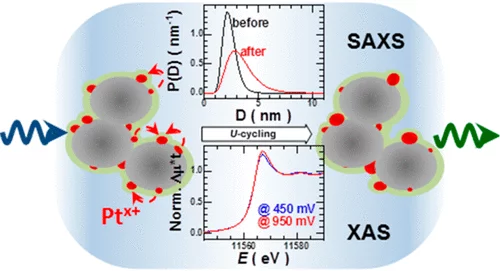In the last two decades, small-angle X-ray scattering (SAXS) and X-ray absorption spectroscopy (XAS) have evolved into two well-established techniques capable of providing complementary and operando information about a sample’s morphology and composition, respectively. Considering that operation conditions can often lead to simultaneous and related changes in a catalyst’s speciation and shape, herein we introduce a setup that combines SAXS and XAS in a configuration that allows optimum acquisition and corresponding data quality for both techniques. To determine the reliability of this setup, the latter was used to study the operando degradation of two carbon-supported Pt-nanoparticle (Pt/C) catalysts customarily used in polymer electrolyte fuel cells. The model used for the fitting of the SAXS curves unveiled the fractal nature of the Pt/C-electrodes and their evolution during the operando tests, and both X-ray techniques were complemented with control, ex situ transmission electron microscopy, and standard electrochemical measurements. Ultimately, the results obtained with this combined setup quantitatively agree with those reported in previous studies, successfully validating this apparatus and highlighting its potential to study the operando changes undergone by worse-understood (electro)catalytic systems.
Contact Dr Maarten Nachtegaal
SuperXAS beamline
Laboratory for Synchrotron Radiation and Femtochemistry (LSF)
Swiss Light Source, Paul Scherrer Intitute
5232 Villigen-PSI, Switzerland
Telephone: +41 56 310 30 56
E-mail: marten.nachtegaal@psi.ch
Original Publication
Combining SAXS and XAS To Study the Operando Degradation of Carbon-Supported Pt-Nanoparticle Fuel Cell CatalystsMauro Povia, Juan Herranz, Tobias Binninger, Maarten Nachtegaal, Ana Diaz, Joachim Kohlbrecher, Daniel F. Abbott, Bae-Jung Kim, and Thomas J. Schmidt
ACS Catalysis, June 19 2018
DOI: 10.1021/acscatal.8b01321
